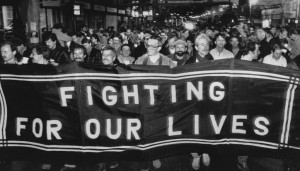The End of Aids
< < Go Back
San Francisco was ground zero for HIV in the U.S. Now it wants to be the first city in the world with no new infections, no stigma—and no deaths.
a groundbreaking program called RAPID (Rapid Antiretroviral Program Initiative for new Diagnoses), a public-health strategy launched in 2013 by the University of California, San Francisco (UCSF), San Francisco General Hospital (SFGH) and the city’s public-health department, with support from local pharmacies and activists. It’s a comprehensive plan meant to erase the financial and social barriers to getting tested and treated for HIV.
RAPID impels people who don’t know their HIV status to get tested and tracks down those who are positive before shuttling them from HIV testing centers, which can’t dispense drugs, to hospitals, which can. After that, there are follow-ups to make sure that the patients stay on their meds–and that the drugs are working.
The reason for the urgency is simple: the more HIV-positive people who know their status, the more people who can start treatment. And HIV-positive people who take their medications can bring their virus levels down to undetectable levels–a potential lifesaver for them that also leads to less virus circulating that can spread from one person to another. That, say experts, could be the key to finally putting out the fire that has claimed 36 million lives since the 1980s and continues to smolder on nearly every continent, affecting 35 million more.
While [antiretroviral (ARVs) drugs] have been around since 1987 and doctors have been using them in powerful cocktails since 1996, [doctors] were compelled by more recent studies that revealed that the sooner people start taking them, the healthier they would be. Someone who begins treatment as soon as possible after infection can protect his immune system from being ravaged.
Within a few years of the first AIDS cases’ being reported in the U.S. in 1981, San Francisco became the hub of the country’s epidemic, peaking at more than 5,000 cases per year in the 1980s. The local health department opened the country’s first HIV clinic and first inpatient AIDS ward, both at SFGH, which quickly filled its several dozen beds. But with no treatments and only a basic understanding of the virus, the ward became a hospice where AIDS patients went to die.
More than three decades later, the disease has killed over 650,000 Americans, and the HIV/AIDS landscape, thankfully, has changed. At its peak, there were 50,000 deaths from the virus per year; now the number is 15,000. Lately, the rate of new HIV infections has stabilized at about 50,000 annually, and more than 1 million people in the U.S. are now living with an HIV diagnosis.
San Francisco has been confronting this challenge for several years, ramping up its efforts in the past 12 months, and so far that’s been paying dividends.
More From TIME Magazine:




